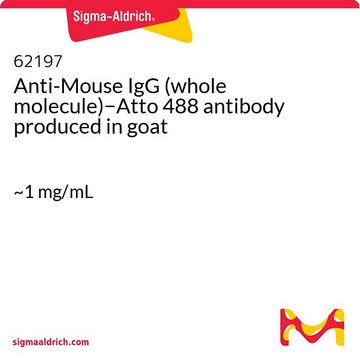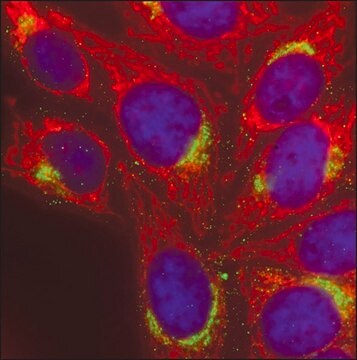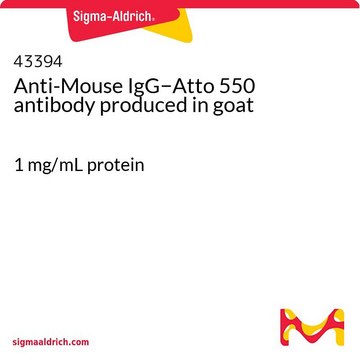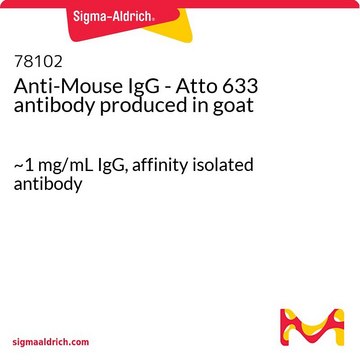41176
Anti-Rabbit IgG - Atto 633 antibody produced in goat
1 mg/mL IgG
Synonym(s):
Atto 633 [goat-Anti-rabbit IgG]
Sign Into View Organizational & Contract Pricing
All Photos(1)
About This Item
UNSPSC Code:
12352203
NACRES:
NA.46
Recommended Products
biological source
goat
conjugate
Atto 633 conjugate
antibody form
affinity isolated antibody
antibody product type
secondary antibodies
clone
polyclonal
contains
50% glycerol as stabilizer
species reactivity
rabbit
concentration
1 mg/mL IgG
technique(s)
immunohistochemistry: 1:200
fluorescence
λex 636 nm; λem 650 nm in PBS
storage temp.
−20°C
target post-translational modification
unmodified
General description
Anti-rabbit IgG (whole molecule) (Sigma, R4880) is developed in goat using purified rabbit IgG as the immunogen. Affinity isolated antigen specific antibody is purified from goat anti-rabbit IgG antiserum to remove essentially all goat serum proteins, including immunoglobulins, which do not specifically bind to rabbit IgG. Goat anti-rabbit is conjugated to Atto 633 NHS (Abs.max. 629 nm; Em.max. 657 nm), (Cat. No. 01464), then further purified via gel permeation chromatography and dialysis to remove unbound Atto-Dye.
Immunogen
purified rabbit IgG
Application
Goat anti-rabbit IgG can be used for immunohistochemical applications at a dilution of 1:200.
Analysis Note
unconjugated dye ≤5% of total fluorescence
Legal Information
This product is for Research use only. In case of intended commercialization, please contact the IP-holder (ATTO-TEC GmbH, Germany) for licensing.
Disclaimer
Unless otherwise stated in our catalog or other company documentation accompanying the product(s), our products are intended for research use only and are not to be used for any other purpose, which includes but is not limited to, unauthorized commercial uses, in vitro diagnostic uses, ex vivo or in vivo therapeutic uses or any type of consumption or application to humans or animals.
Not finding the right product?
Try our Product Selector Tool.
related product
Product No.
Description
Pricing
Storage Class Code
10 - Combustible liquids
WGK
WGK 3
Flash Point(F)
Not applicable
Flash Point(C)
Not applicable
Personal Protective Equipment
dust mask type N95 (US), Eyeshields, Gloves
Choose from one of the most recent versions:
Already Own This Product?
Find documentation for the products that you have recently purchased in the Document Library.
Fanny Dussert et al.
Frontiers in toxicology, 3, 636976-636976 (2022-03-18)
Quantum dots (QDs) are colloidal fluorescent semiconductor nanocrystals with exceptional optical properties. Their widespread use, particularly in light-emitting diodes (LEDs), displays, and photovoltaics, is questioning their potential toxicity. The most widely used QDs are CdSe and CdTe QDs, but due
Maëva Clerte et al.
Journal of the American Society of Echocardiography : official publication of the American Society of Echocardiography, 26(12), 1465-1473 (2013-09-03)
When activated by the sympathetic nervous system, brown adipose tissue (BAT) increases energy expenditure to produce heat. Augmenting BAT mass or increasing BAT activation could potentially be used to decrease obesity. Noninvasive methods to detect and monitor BAT mass are
Tharun Selvam Mahendran et al.
Frontiers in aging neuroscience, 12, 537712-537712 (2020-12-01)
Aggregated tau is a hallmark neuropathological feature in numerous neurodegenerative disorders. Previous studies aiming to validate aggregated tau pathology as a pathogenic driver of neurodegeneration in correlation to characteristic behavioral phenotypes have had shortcomings. Although studies on soluble tau pathology
S N Suresh et al.
Frontiers in molecular neuroscience, 11, 109-109 (2018-04-25)
Mechanistic insights into aggrephagy, a selective basal autophagy process to clear misfolded protein aggregates, are lacking. Here, we report and describe the role of Estrogen Related Receptor α (ERRα, HUGO Gene Nomenclature ESRRA), new molecular player of aggrephagy, in keeping
Piyush Mishra et al.
Autophagy, 13(9), 1556-1572 (2017-08-10)
Due to the involvement of macroautophagy/autophagy in different pathophysiological conditions such as infections, neurodegeneration and cancer, identification of novel small molecules that modulate the process is of current research and clinical interest. In this work, we developed a luciferase-based sensitive
Articles
Fluorescent Multiplex Detection using Antibody Atto Dye Conjugates
Our team of scientists has experience in all areas of research including Life Science, Material Science, Chemical Synthesis, Chromatography, Analytical and many others.
Contact Technical Service








